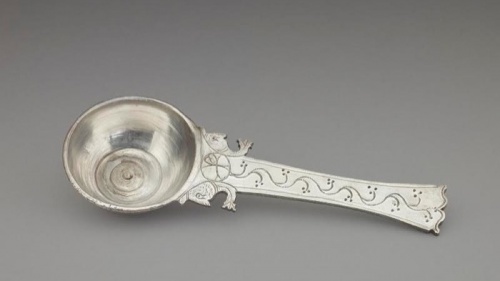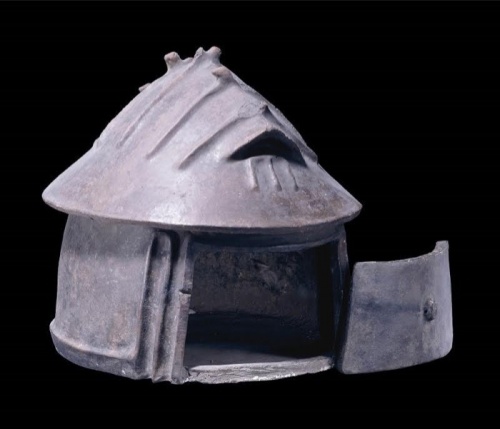
THIS large exhibition is rich in history and demands careful viewing and reading to maximise the experience.
Many small objects from materials that make up the decorative arts – clay, jewellery, mosaics, silver and other metals, glass, bone and ivory – are on exhibit. There should be no surprise these works demonstrate extraordinary skills – they are all handmade and the same methods of making objects from clay, silver and bone are still used today.
Glass as a material is thought to have been discovered, probably in Egypt, around 2500 BCE with solid objects being made extensively from 1500 BCE. Glass blowing was discovered early in first century BCE. Most of the glass objects in the exhibition are vessels and most are not purely functional but also decorative. Two ribbed glass bowls were found hundreds of kilometres from each other, although they were probably made in Italy. Rather than being moulded (as was originally thought) it appears the hot glass was pulled and trimmed.
An elegant glass phial – decorated with applied glass – which probably contained perfume or lotion, was found in Israel and is from 400-500 CE. The decoration is fine, and highlights the narrow neck, the mouth and the sides of the object.
A ceramic burial urn represents a thatched house with wattle and daub walls in which people would have lived. It was used by people who lived in the cottages, and contrasts with the elaborate carved alabaster and marble burial chests sarcophagi used by wealthy citizens.

A glass drinking horn is exhibited alongside a fragment of a wall painting, showing a man drinking from a similar horn. The raised surface pattern of the horn is both decorative and functional, providing a non-slip surface. The Romans were great drinkers, but it’s not known if they drank the contents at once, or handed it to a slave in between drinks.
Jewellery has always been worn by both women and men for identification, protection and decoration. Many pieces of jewellery are exhibited such as bangles, earrings, brooches and necklaces. A sealstone ring in gold and jasper, probably made in Italy around 40 BCE, depicts Mark Antony and shows no wear at all. The carving is delicate and fine, showing a man’s profile, with a rather subdued look. Another beautiful carving is a cameo made from sardonyx – which has layers of colour – featuring a Cretan Goat. It was probably made in Italy in the first or second century CE. The goat is sitting with its legs tucked under it, and its beard and horns are prominent. The stone is said to have healing qualities.
Mosaics fulfilled several functions. They were decorative reflecting the owner’s taste, personality and wealth, and were conversation pieces. They were used to decorate and cover floors and walls of the most ostentatious houses. Several fine examples are on exhibit.
What appealed to me most were the numerous pieces made from silver, including small plates, cups and many spoons, and a very delicate toothpick. These works could have been made yesterday, showing the viewers that fine craftspeople worked in the days of the Roman Empire, as they do today.
In addition to the historical information, I would have liked a little more information about the way the pieces were made.
There is so much to see and take in, in this exhibition. The carved marble works are amazing, with a great deal of detail in the draping of togas and gowns, hair styles, eyes, and faces. Viewers are given many opportunities to get close and examine the level of detail.
I highly recommend this exhibition for its wide-ranging scope, both geographically and historically, and the sheer beauty of many exhibits.
Who can be trusted?
In a world of spin and confusion, there’s never been a more important time to support independent journalism in Canberra.
If you trust our work online and want to enforce the power of independent voices, I invite you to make a small contribution.
Every dollar of support is invested back into our journalism to help keep citynews.com.au strong and free.
Thank you,
Ian Meikle, editor



![Evie Hudson is a woman with amnesia, who forgets the last 13 years. Piecing her life back together, she navigates the harsh realities of coercive control.
Evie is the leading character in local author @emmagreyauthor's second novel Pictures of You.
Her debut book, The Last Love Note, sold more than 100,000 books worldwide within a few months of being published last year.
“I think that using amnesia really helped [show the effects of coercive control] because she had that sense of being completely lost in her own life,” Emma says of her new work of fiction.
To read the full story and find out more about this fabulous local author and her latest novel, visit our website at citynews.com.au or click the link in our bio! 📚✒️
#canberra #local #canberralocals #canberralife #australia #author #localauthor #Picturesofyou #coercivecontrolisabuse #dvawareness #bestsellingauthor #canberraauthor #localnews #citynews](https://citynews.com.au/wp-content/plugins/instagram-feed/img/placeholder.png)
Leave a Reply